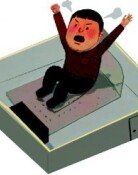New approach needed for future Korea-China economic cooperation
New approach needed for future Korea-China economic cooperation
Posted November. 14, 2017 07:33,
Updated November. 14, 2017 08:50
President Moon Jae-in, who is on a visit to the Philippines to attend the Association of Southeast Asian Nations (ASEAN) summit, sat down with Chinese Premier Li Keqiang Monday and discussed practical measures to promote bilateral economic cooperation. The meeting was a follow-up to the agreement made two days earlier in the Korea-China bilateral summit to put an end to conflicts over the deployment of the Terminal High Altitude Area Defense (THAAD) system and to normalize ties in all areas. In the Korea-ASEAN summit earlier held, President Moon unveiled his future vision to enhance economic relations with ASEAN to the level of those with the United States, China, Russia and Japan.
With the damage sustained by Korean businesses estimated at over 13 trillion won due to China’s economic retaliation over the deployment of the THAAD system since July last year, the resumption of Korea-China economic cooperation will come as a great relief to the country’s many businesses. However, we should not be swayed by partially favorable developments such as the influx of Chinese tourists or active cultural exchange with the Korean Wave. In economically engaging with China in the future, our government and businesses should take an attitude that is radically different from before.
While China focused on processing trade in the past in which it imported intermediary goods from Korea and export them back, now the country boasts technical competitiveness high enough to produce intermediary and complete products all by itself. Moreover, Chinese President Xi Jinping has shifted the paradigm of China’s economic policies to focus on domestic demand, moving away from exports. The retaliation over the installation of the U.S. THAAD battery in Korea was also in line with the country’s industry rearrangement. With China focusing on the growth of its domestic market, we need to expand export items to include items in the service sector.
Also, now is the time we should maximize the technical competitiveness of Korean products shipped to China as its industrial structure nears completion. Take semiconductors as an example. It is the competitiveness of memory chips that enables Samsung Electronics to maintain its sales in China even though Chinese tech companies already rose as front runners in the global market. As such, technical competitiveness should be secured not only in semiconductors but also in bio and environment sectors for us to take a lead in the global market and make the most use of the Chinese market.
The diversification of markets should also be accompanied. The industrial structure of importing semiconductor parts to assembly and exporting finished products once sustained by China is now formed in Southeast Asian countries. In this sense, President Moon’s vision to expand economic cooperation with ASEAN will serve as an opportunity to grow the export base of manufacturers. Economic cooperation can bear fruit only when it is in mutual interest and reciprocally beneficial. We should bear in mind that no matter how important China’s role is in resolving North Korea’s nuclear issues, a series of economic retaliation can hit us again at any time when China believes that bilateral cooperation does not benefit its economy.







